
When it comes to 1911 type pistols, it sometimes takes an effort to discern their differences. Price tags, brand and shooting precision can contribute to assessment, but there are plenty of expensive but mediocre firearms, no brand always gets it right all of the time and precision is good only as long as it lasts. Subsequently, it pays to take a close look.
What is the intended application?
Application really matters, not only for 1911 types, but for any firearm. The context is necessary to determine appropriateness of materials employed, tolerances and fit and finish. Intended applications set expectations for accuracy and what constitutes an acceptable price tag. So what about the Smith & Wesson SW1911TA?
The SW1911 TA is intended for recreational and competitive combat shooting, self defense, and professional duty applications. It would be reasonable for a pistol intended for this use to have features like an ambidextrous safety, grip safety contact pad, lightweight hammer and trigger, fixed night sights, and tactical accessory rail.
|
Smith & Wesson SW1911TA E |
|
| Company | Smith & Wesson |
| Point of Manufacturer | Springfield, MA |
| SKU # | 108409 |
| Type of Action | Short Recoil Tilting Barrel |
| Caliber | 45 Automatic |
| Capacity | 8+1 |
| Barrel Length | 5.00“ |
| Barrel Material | Stainless |
| Rifling Twist Rate | 1:15″ |
| Slide Material | Stainless |
| Slide Finish | Black Melonite |
| Frame Material | Stainless |
| Frame Finish | Black Melonite |
| Grips | Wooden Laminate |
| Front Sight | Tritium Dot |
| Rear Sight | Tritium Two Dot Fixed |
| Weight of Firearm | 41.70 Oz |
| Trigger Pull | 4lbs 6 oz |
| Overall Length | 8.70″ |
| Overall Height | 5.62″ |
| Width | 1.25″ @ Grip |
| Thumb Safety | Ambi Thumb |
| Grip Safety | Yes |
| Magazine Disconnect | No |
| Loaded Chamber Port | Yes |
| Key Lock | No |
| CA Approved | No |
| MA Approved | Yes |
| MD Approved | Yes |
| MSRP | $1,399 |
A pistol of this type should have fixed sights and it sould be assembled with clearances to assure very reliable operation and with trigger/sear engagement that would assure no accidental discharge in the event of a dropped pistol with a loaded chamber.

The expression, “The plastic part is as good as steel” isn’t true. The only reason for the existence of a plastic mainspring housing on a 1911 is to save cost in manufacturing. As a manufacturing direct material cost, I would guess a plastic mainspring housing is a $1.50 part with a steel piece in the $8 to $12 range. At retail, a plastic housing is an $8 part and a basic steel mainspring housing is a $35 to $50 part, which is the reality if one is changed out after purchase of a pistol. Personally, I think plastic has no place on a 1911 other than, perhaps, really low prices imports where price is THE issue. Apparently, S&W agrees as the SW1911TA has a steel mainspring housing.
When I first saw the fish scaled gripping surfaces on S&W products I wondered how many ways manufacturers could dream up, just to be different. Then I picked up a S&W autoloaders and racked the slide effortlessly with two fingers and with palm over slide. The scalloping is a directional surface that works with hands wet or dry, oily or sweat making them much better than multiple rows of diagonal serrations.
The trigger face is grooved, lightweight to reduce the chance of follow on shots and externally adjustable for over travel. The trigger is light, no creep and a very clean release. Integrated into the dust cover is a 1913-spec Picatinny rail for accessory mounting.
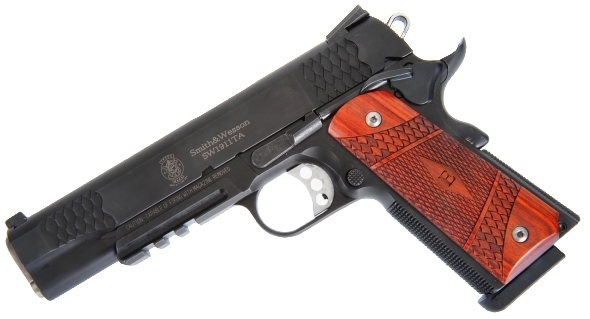
The front and back strap are covered in 30 lines per inch checkering and the grip surface is heavily checkered in varying panels. This is not a pistol that will slip out of a shooter’s hand, The curved recess under the trigger guard and the contour of the grip safety and beavertail make for a natural high hold. The safety and slide stop control surfaces are striated, the magazine release is checkered, and the safeties are tucked in; plenty of surface for actuation without getting in the way.

More touches for the intended applications. The Tritium sights are dovetail mounted, the rear sight is windage adjustable and low profile. The slide top is milled flat with serrations running between sight to kill any glare that would diminish the sight picture. A better shot to illustrate how the safety controls are kept tucked into the sides of the frame.
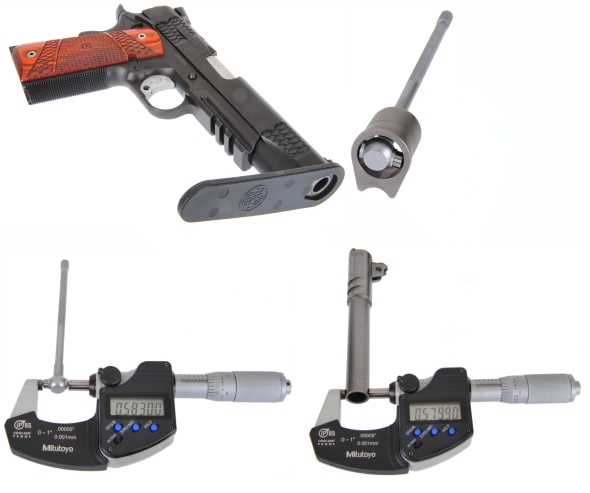
The bushing to slide fit was snug; a wrench was needed to twist to release when new. Bushing to barrel clearance measured approx 0.003″, no binding. A good fit for a duty pistol that needs to be rock solid reliable.
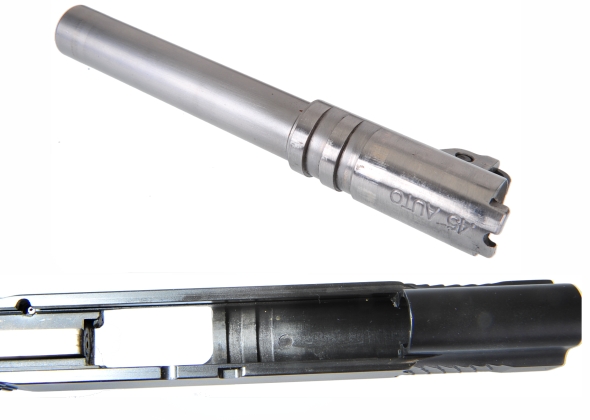
Barrel and slide lugs were cut cleanly, centered, uniform. Engagement was just above full contact when depth checked with modeling clay.
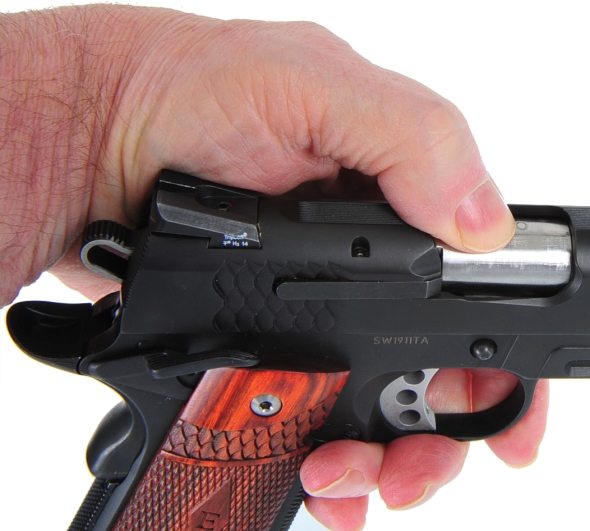
There was zero barrel hood squat suggesting a tight link and slide stop pin fit. Breech face clearance with the slide in battery was too minimal to accept the thinnest shim stock between the hood and breech face.

The slide is centered to the frame, front and rear, dust cover to slide, frame and slide rails. This would seem like a normal expectation, however, this is often not the case with low end 1911s with sloppily cast pieces. You get what you pay for. There was minimal movement of slide on frame, even when applying a good deal of side load in a rocking motion. Slide movement on frame rails was very smooth.
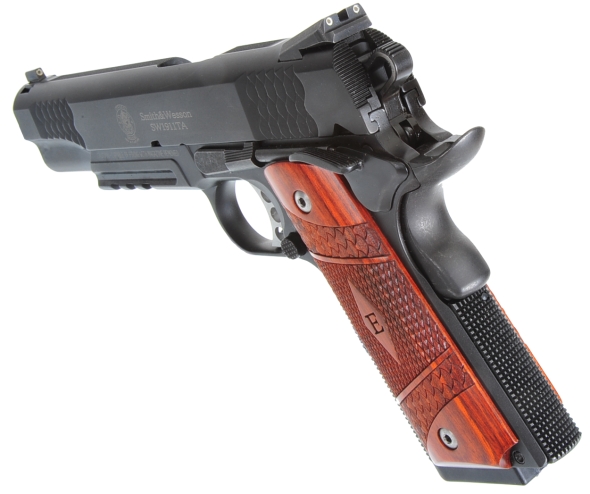
The SW1911TA is not a Performance Center or Champion or Pro Series pistol. It is a standard production piece, yet it is fit and finished to a very high standard and I would suspect it would perform reliably for a very long time.
Live fire…
The Smith &Wesson SW1911TA was shot with 185 grain semi wad cutter handloads and 230 Grain Remington Ultimate Home Defense ammo; 850 and 875 fps respectively. The pistol digested either as easily and cycled normally.
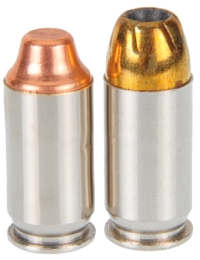
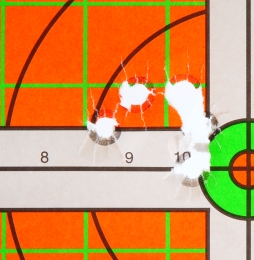
The best 50′ five shot group was shot with the 185 grain wad cutters, 1.5″. The best group shot with the Remington ammo was just under 2″, again, 5 shots at 50′. Both were shot from a solid sandbag rest. Performance was consistent.
Conclusions…
The S&W Model SW1911TA E-Series is not a Performance Center product, but even a very experienced shooter would be hard pressed to see the difference other than perhaps some very subtle hand fitting that is the hallmark of a PC firearms. The subject pistol is very slick, very nicely finished and out of the box accurate. It is an excellent bridge between the typical higher end 1911 types and the $3,000 to $4,000 custom guns. Nice pistol, no matter how closely you look at it.
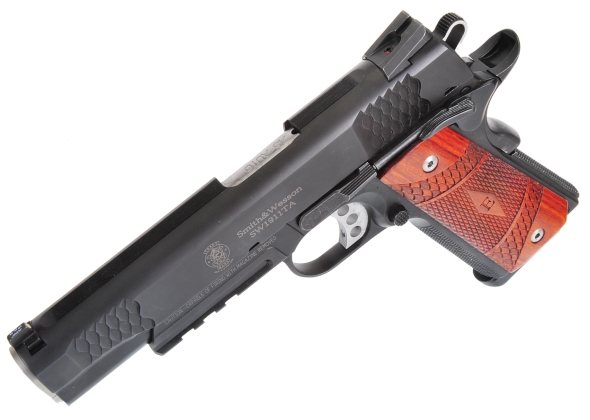

Email Notification